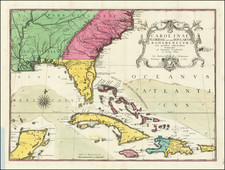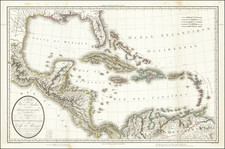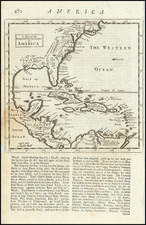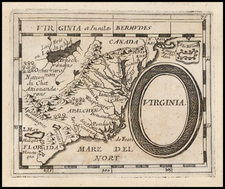Fine example of this striking view of the Potomac River, drawn by William Roberts and engraved by J. Jeakes.
The following excerpt is from Barbara C. Baston's article, Virginia Landscapes by William Roberts, which appeared in the Journal of Early Southern Decorative Arts (Vol X, #2, 1984):
The artist, William Roberts, remains largely obscure; the years of his birth and death, his training, even his nationality - all are unknown or uncertain. Manuscript notes on two (f his 3 Virginia) prints provide a tantalizing bit of information, however. View on the Potomac in the MESDA collection is inscribed "Mr. Burton / 91 Gloster Place / Por . . . . " A similar inscription is on the handcolored aquatint, Junction of the Potomac and Shenandoah Rivers, Virginia, owned by the New York Public Library: "Original picture in oils at 91 Gloucester Place. Painted by Mr. Roberts, father to Mrs. Grace Burton, Mother of Sir Charles Burton." Burke J Dictionary of Peerage and Baronetage of the British Empire notes that Benjamin Burton of Dublin, lieutenant of the 19th Lancers, married Grace-Anne Roberts, who was the "only child of William Roberts, Esq. 91 Gloster-Place, Por[t]man- square. ' ' Their eldest child and son, Charles William Cuffe Burton (1823-1902) inherited the baronetcy, married, and died without issue. The title and his estate, presumably including the painting by his grandfather, passed to his niece, Grace Ellen Burton, and her husband. Sir Francis Denys."
Roberts nevertheless had at least one tie to America. In two letters to Thomas Jefferson, who owned two oils by Roberts -one of Natural Bridge and another of Harper's Ferry - Roberts mentioned his brother, Edward, a merchant in Norfolk, Virginia. In his letter of 24 July 1803, Roberts wrote that he was "lately from Norfolk, taking an Excursion with his Sister Mrs Taylor and presuming on the honour of having been introduced to Mr. Jefferson almost an age ago in London by Hector St John Author of 'Letters by an American Farmer'; intended to take the liberty this morning of expressing the singular gratification he should derive from an opportunity of renewing his respectful remembrance. . . " However, Roberts probably did not make the preliminary sketches for the three prints while on this tour. The paper upon which both. Junction of the Potomac and Shenandoah
and View on the Potomac were printed as well as the paper used for the wash drawing oi Junction all bear an 1808 watermark.
* * *
The latest print of the three is View on the Potomac, Virginia Manuscript notes record that Conalghi and Co. published the print in March, 1810, and the paper is watermarked "J
WHATMAN / 1808. The print, engraved by Joseph Jeakes, presents a placid pastoral scene to the viewer. The roughness of the surfaces of the trees at left and the gently sloping hills of the foreground satisfy the requirements of a "picturesque" view
advocated by Rev. Gilpin. The picturesque, according to Gilpin, was a compromise between the beautiful, characterized by smoothness, and the sublime, which was depicted with violently rugged lines. "A distance," wrote Gilpin, "must stretch away many leagues from the eye; it must consist of various intermediate parts; it must be enriched by numerous objects, which lose by degrees all form and distinctness; and finally perhaps terminate in faint purple mountains, or perhaps mix with the blue mists of ether, before it can pretend to the character oi grandeur.'' The emphasis on gradual recession into space, gently undulating hills, and contrast of dark foreground and light middle ground is well observed in View on the Potomac. The foreground is dark and slightly elevated to allow a gentle transition for the spectator to be drawn into the scene. The middle ground contains the strongest light which gradually fades into the distance. The trees, which serve to border the scene, are tall with their foliage confined to the crowns to better reveal their rough bark. Roberts turned the people in the foreground away from the spectator as if to invite
meditation in quiet company. In scenes such as View on the Potomac intellectual and emotional pleasure was the goal, quite unlike the physical reaction suggested by Natural Bridge.
We have located the copy at the New York Public Library an example which was offered for sale by Christies New York, January 26-27, 1995, Lot 195, which sold for $1,265.










![[ Pictish Warrior Woman ] Feminae Pictae icon V](https://storage.googleapis.com/raremaps/img/small/99648.jpg)



